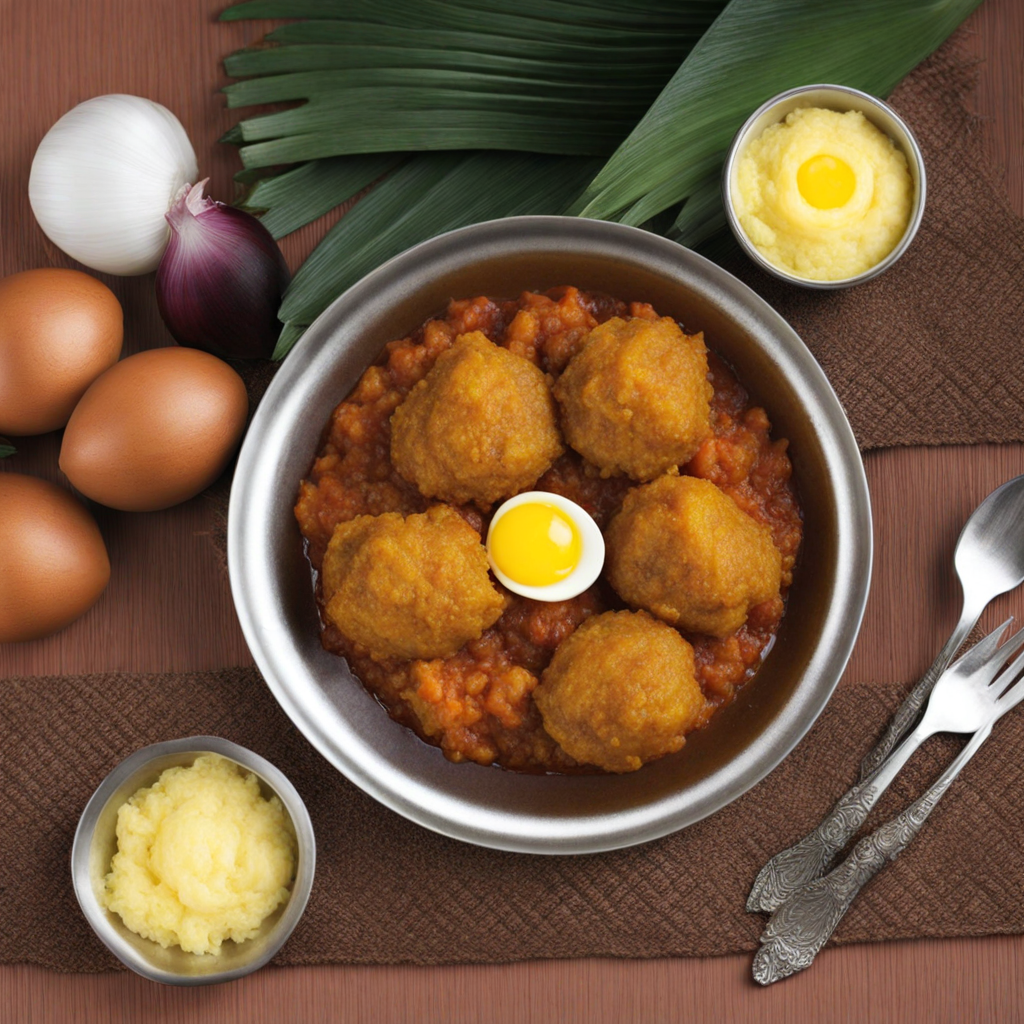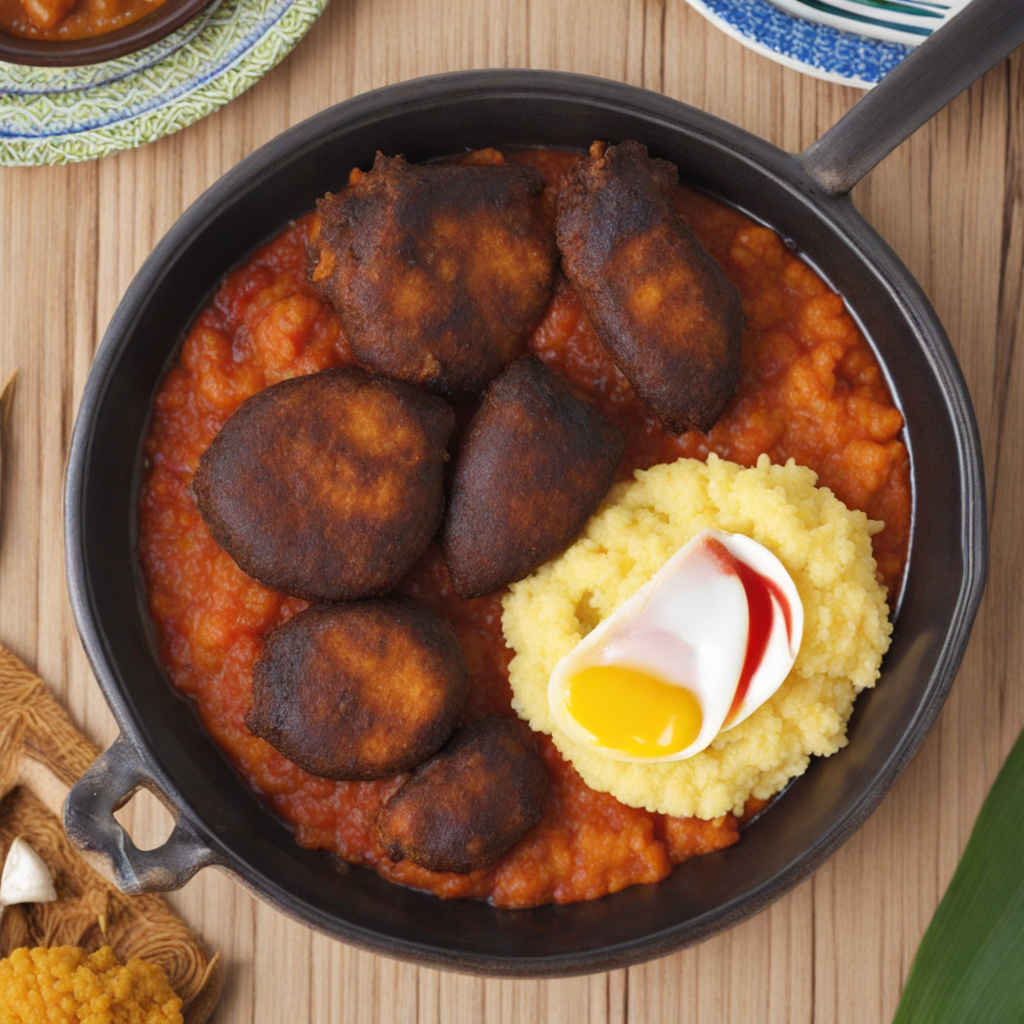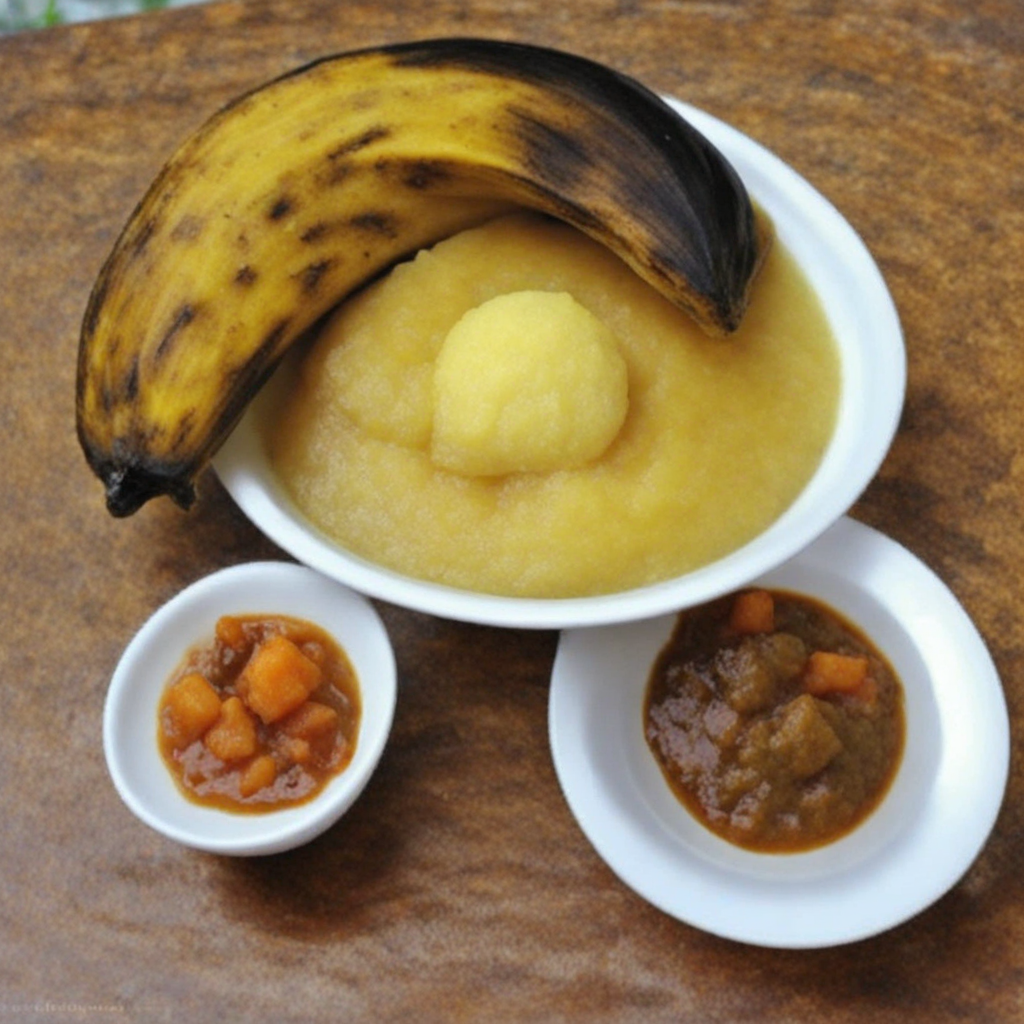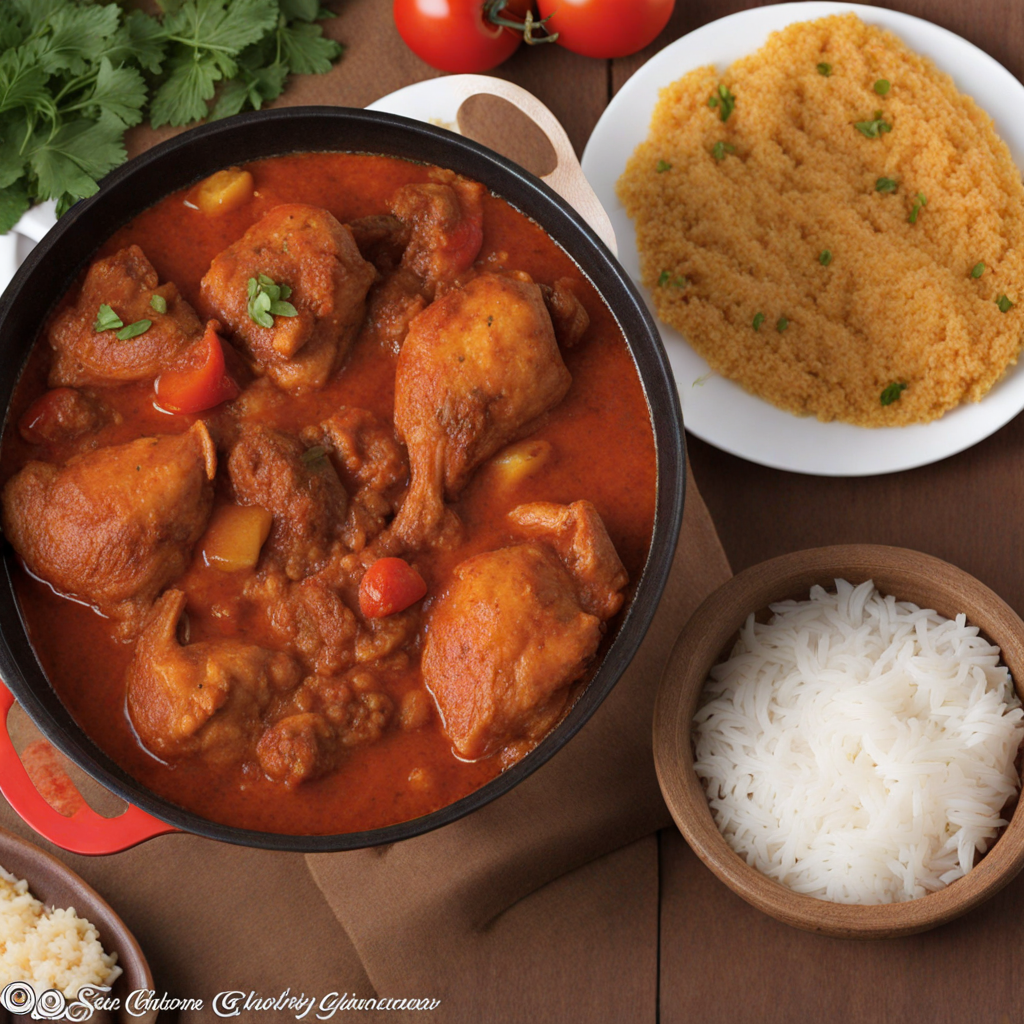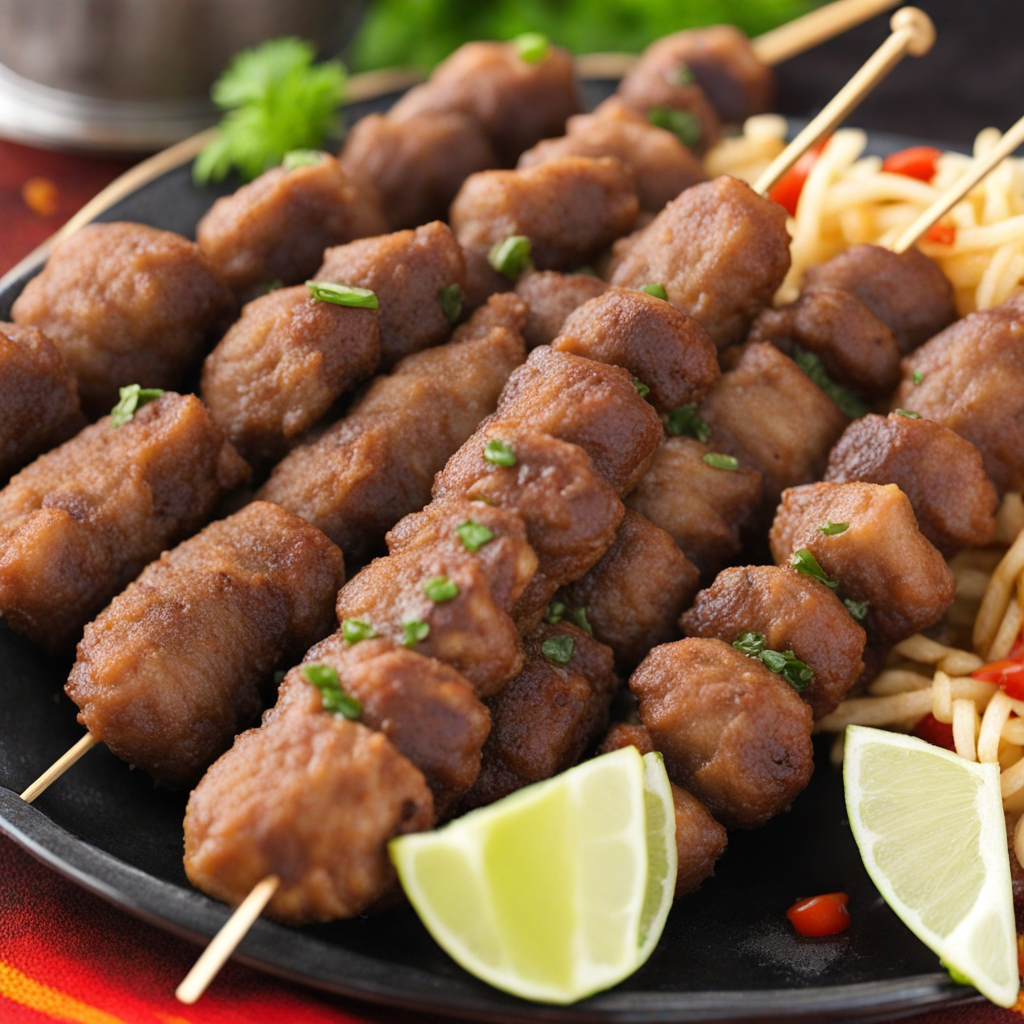Etor
Etor is a traditional Ghanaian dish that embodies the rich culinary heritage of the country, offering a unique blend of flavors and textures that are sure to tantalize your taste buds. The main ingredient of Etor is usually made from mashed ripe plantains or cassava, which are cooked until soft and then pounded to a smooth, creamy consistency. This starchy base serves as the perfect canvas for the accompanying ingredients, which often include a variety of spices, herbs, and sometimes even a sprinkle of peanuts for added crunch and richness. One of the most delightful aspects of Etor is its versatility. It can be paired with a variety of savory accompaniments, such as spicy stews made from tomatoes, onions, and peppers, or a protein source like fish, chicken, or beef. The dish is typically served warm and can be enjoyed as a hearty breakfast, lunch, or dinner option. Each bite offers a comforting, slightly sweet flavor from the plantains or cassava, balanced by the spiciness and aromatic qualities of the accompanying sauces and proteins. In Ghanaian culture, food is often a communal experience, and Etor is no exception. It is commonly shared among family and friends, reflecting the warmth and hospitality of the Ghanaian people. The dish not only satisfies hunger but also brings people together, making it a staple at gatherings and celebrations. For those seeking to explore new tastes, Etor provides a delightful journey into the heart of Ghanaian cuisine, inviting you to savor the rich flavors and cherished traditions that accompany this beloved dish.
How It Became This Dish
Etor: A Journey Through the Heart of Ghanaian Culinary Tradition Etor, a traditional Ghanaian dish, is more than just sustenance; it is a culinary embodiment of community, culture, and history. This dish, primarily made from fermented corn and served with a variety of toppings, is deeply rooted in the customs of the Akan people of Ghana and has evolved over time to reflect the changing dynamics of society, agriculture, and food practices. Origins of Etor The origins of Etor can be traced back to the agricultural practices of the Akan people, who have been cultivating maize (corn) for centuries. Maize was introduced to West Africa in the 16th century by European traders and quickly became a staple crop in the region. Its adaptability to various climates and soils made it a favored choice for farmers across the country. The traditional method of preparing Etor involves fermenting maize, which not only enhances its flavor but also increases its nutritional value. This fermentation process is a technique that has been used in various cultures around the world to preserve food and improve digestion. In Ghana, the fermentation of maize is often accompanied by the addition of water and sometimes groundnut paste or palm oil, resulting in a thick, porridge-like consistency. Cultural Significance of Etor Etor is much more than a meal; it is a symbol of communal bonds and cultural identity among the Akan people. It is traditionally served during special occasions, celebrations, and rituals. For instance, during festivals, weddings, and naming ceremonies, Etor plays a pivotal role in the communal feast, where it is often shared among family and friends. The act of sharing food in Ghanaian culture signifies love, unity, and hospitality. Moreover, the preparation of Etor is often a communal activity. Families come together to prepare large batches, fostering social interaction and strengthening community ties. This collective approach to food preparation reflects the Ghanaian philosophy of "Nkyinkyim," which emphasizes interdependence and the importance of community. Etor also carries religious significance in some Akan communities. It may be offered to ancestors during ceremonial events as a way of honoring their spirits and seeking blessings. This connection between food and spirituality underscores the role of Etor in the cultural fabric of Ghana, reinforcing the idea that what we eat is intertwined with our beliefs and traditions. Development Over Time As Ghana has modernized and globalized, so too has the preparation and consumption of Etor. In the past, the dish was primarily prepared in rural areas where maize was abundant and fermentation techniques were passed down through generations. However, with urbanization and the migration of people to cities, the way Etor is made has evolved. In urban settings, convenience has become a priority. While traditional methods of fermentation can take several days, many modern cooks have adapted recipes to speed up the process. Some have turned to commercially available fermented maize flour, which significantly reduces preparation time. This change reflects a broader trend in Ghanaian cuisine, where traditional foods are being adapted to fit the fast-paced lifestyles of urban dwellers. Despite these changes, the essence of Etor remains intact. Many urban Ghanaians still cherish the traditional flavors and textures of homemade Etor, and there is a growing movement to preserve and celebrate this culinary heritage. Food festivals, cultural events, and cooking classes are increasingly focusing on traditional dishes like Etor, emphasizing the importance of maintaining these culinary practices in the face of modernization. Additionally, the increasing awareness of health and nutrition has led to a renewed interest in the nutritional benefits of fermented foods, including Etor. The fermentation process not only enhances flavors but also introduces probiotics that are beneficial for gut health. This resurgence in interest aligns with a global trend towards healthier eating, making Etor not only a cultural staple but also a viable option in contemporary diets. Contemporary Variations of Etor In recent years, innovative chefs and home cooks have begun to experiment with Etor, incorporating new ingredients and flavors to appeal to a broader audience. For instance, some variations include the addition of vegetables, spices, and proteins such as fish or chicken. These adaptations not only modernize the dish but also create opportunities for fusion cuisines that blend traditional Ghanaian flavors with international influences. In addition, the rise of social media has played a pivotal role in promoting Ghanaian cuisine, including Etor. Food bloggers and influencers have showcased traditional dishes to a global audience, sparking interest and appreciation for Ghanaian culinary traditions. This visibility has encouraged younger generations to reconnect with their heritage, often leading to a revival of traditional cooking methods and recipes. Conclusion Etor is a dish that encapsulates the spirit of Ghana—a rich tapestry of history, culture, and community. From its origins rooted in the agricultural practices of the Akan people to its contemporary interpretations in urban settings, Etor serves as a reminder of the importance of food in shaping cultural identity. As Ghana continues to navigate the complexities of modernization, the enduring legacy of Etor highlights the necessity of preserving culinary traditions while embracing innovation. Through its communal significance, nutritional benefits, and adaptations over time, Etor stands as a testament to the resilience and dynamism of Ghanaian culture. As we savor this dish, we not only enjoy a meal but also partake in a shared history that binds generations together, ensuring that the flavors of the past continue to nourish the future. Whether enjoyed in a bustling city or a quiet village, Etor remains a beloved symbol of Ghanaian heritage, reminding us that food is not just about sustenance but a celebration of life, connection, and continuity.
You may like
Discover local flavors from Ghana


